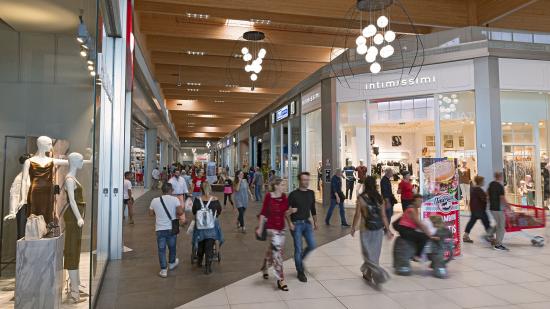The Chief Executive Officer’s point of view on the first six months of 2022

The Chief Executive Officer, Claudio Albertini, provides us with an interpretation of the results IGD achieved in the first six months of the year.
In what was a very challenging environment for the retail sector, the Group succeeded in following the trajectory outlined in the Business Plan presented in December of last year. There were several areas of improvement recorded in the income statement: EBITDA rose 2.3% while there was a 0.84% increase in fair value like-for-like.
Gruppo IGD’s financial profile is solid and sustainable, with no need for refinancing until 2024 thanks to the successful liability management transactions were completed recently. In light of these half-year results, the time needed for the impact of the recent pre-lets to materialize, as well as, naturally, the impact of the new global market scenario, the 2022 guidance for FFO growth is now in a range of between 2 and 3%.
Let’s listen to what the Chief Executive Officer has to say about how the results were achieved and what to expect in the second half of the year.
Dear Shareholders,
as Covid-19 contagion declined and the restrictive measures were eased, our shopping centers began, once again, to express the importance of their role, delivering a series of reassuring operating results at the end of this first half which improved gradually with each passing month.
Retailers’ sales returned largely to pre-pandemic levels: at June 2022 a slight drop of around 2.0% against the first half of 2019, along with significant improvement of around 29.1% compared to the first half of 2021, were, in fact, reported.
Footfalls rose as contagion fell: there was an increase of 14.8% compared to the first half of 2021, even though pre-Covid levels have yet to be reached. This result, however, should be looked at together with the 17.3% increase in the average ticket against June 2021, which confirms the preference for less frequent, but more targeted, purchases.
The sales of the food anchors were also in good shape, rising 2.9% against the first half of 2021 even though, contrary to the malls, hypermarkets and supermarkets were not subject to restrictions last year. We believe these performances are attributable partially to the investments made by Coop Alleanza 3.0, our most important tenant in terms of revenues, to relaunch its format. We have also embarked on an important co-marketing plan with Coop Alleanza 3.0.
As a result of these operating conditions, we succeeded in improving occupancy, which reached 95.1% for the Italian portfolio at 30 June 2022.
The independent appraisals of our freehold real estate portfolio also provided comforting signals with the fair value at €2,143.5 million, a slight increase of 0.14% against year-end 2021.
If we look at the income statement for the half that just closed, we can see the improvements made in different areas, from operations to finance.
Core business EBITDA was, in fact, €1.2 million or 2.3% higher than in the first half of 2021, coming in at €51.8 million. The result reflects two drivers: the €1.6 million increase in net rental income, which reached €57.1 million, and the excellent trend in revenue from services, which rose by €0.4 million to €3.7 million. Together these positive factors more than compensated for the higher operating costs (up by around €0.8 million) relating to personnel expense and general overhead.
The core business EBITDA Margin for the freehold properties came to 73.3%, compared to 66.6% in the first half of 2021.
While the impact of the properties’ impairment and fair value adjustments was, overall, negative for €9.8 million, it was € 2.7 million lower than the negative €12.5 million recorded in the first half of 2021.
Adjusted financial expenses, namely net the impact of IFRS16 and IFRS9, were € 2.4 million lower, coming in at €14.3 million. In the first half of 2022 the average cost of debt did, in fact, fall from the 2.20% recorded at year-end 2021 to 2.08% and the interest cover rate rose to 3.74.
The loan-to-value reached 45.5% at 30 June 2022: higher compared to 44.8% at year-end 2021 which reflects the change in the net financial position which reached €1,001 million at 30 June 2022 compared to €987.0 million at year-end 2021 due mainly to the payment of €38.6 million in dividends in May. We expect to see the loan-to-value at lower levels in the second half of the year.
In the area of financial management IGD also worked successfully in the half, covering a large part of the financial needs for all of 2023. After using available liquidity to repay the bond of more than €150 million expiring in April 2022, we renewed two unutilized, committed lines of credit for a total of €60 million.
On 1 August 2022, so after the close of the half, we also finalized an important transaction that is part of the Green Framework published in March 2022. We obtained a three-year €215 million unsecured green loan, with the option to extend if for an additional two years. The proceeds were used to repay a €200 million bank loan, expiring in 2023, in advance.
Looking again at the half-year performance, FFO was €8 million higher like-for-like, an increase of 30.8% compared to the first half of 2021, reclassified to take into account the change in perimeter attributable to the sale of the portfolio of hypermarkets and supermarkets in November. The rise in FFO is explained by the contribution of €6.7 million made by the adjusted core business EBITDA and the decrease of €2.0 million in adjusted financial charges, as well as the €0.7 million drop in rents from leasehold properties as a result of the discounts granted during the pandemic.
As usual, after the close of the first half, we updated our FY FFO guidance for 2022 to reflect a potential increase in a range of between 2 and 3% compared to the FFO of €64.7 million reported in 2021.
The new guidance, which is compared to the estimated growth of 9-10% announced in February, reflects the results achieved thus far and the prospects of the new scenario which is expected to be more complex than in the first half.
We wanted to take into account the impact that inflation and higher borrowing costs could have on household spending, as well as directly on our income statement which benefits from the indexing of the rents in our leases, but is also impacted by higher energy costs for vacancies and the increase in the cost of materials used for capex.
When updating the growth we expect to see in FFO, we also took into account the updated timing for the inauguration of the Officine Storiche section of our development project in Livorno which was moved from fourth quarter 2022 to second quarter 2021, and the benefits of the pre-lets finalized, which will result in a gradual increase in rental income in the second half of 2022 given the additional time needed to complete fit-out work at the new stores.
We are, therefore, working tenaciously to improve our FFO in the year, despite the challenging operating environment, convinced that we have a valid portfolio and a strategy capable of guiding us successfully beyond these difficult years.
Share




